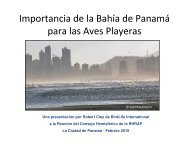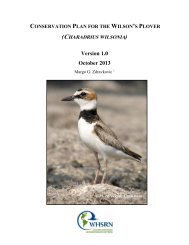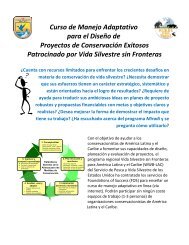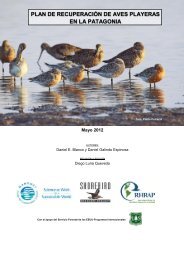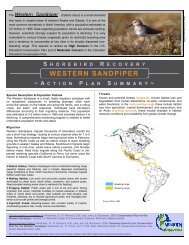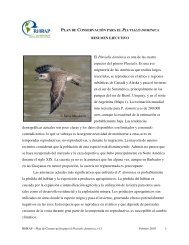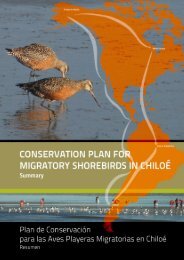Sanderling Plan - Western Hemisphere Shorebird Reserve Network
Sanderling Plan - Western Hemisphere Shorebird Reserve Network
Sanderling Plan - Western Hemisphere Shorebird Reserve Network
Create successful ePaper yourself
Turn your PDF publications into a flip-book with our unique Google optimized e-Paper software.
IMPLEMENTATION OF BENEFICIAL MANAGEMENT PRACTICES<br />
In several parts of the <strong>Sanderling</strong>’s range, management practices are being implemented,<br />
either voluntarily or through legislation, for the benefit of this and other coastal shorebird<br />
species. Some examples follow.<br />
In 2008, legislation was passed in New Jersey to place a moratorium on Horseshoe Crab<br />
harvesting (for bait) along certain Delaware Bay beaches and adjacent waters until shorebird<br />
recovery targets are met (Senate Bill 1331). The majority of weight-gain by migrating shorebirds<br />
in Delaware Bay is from crab eggs (Tsipoura and Burger 1999; Haramis et al. 2007). This<br />
legislation follows numerous legal measures already in place to limit Horseshoe Crab harvest in<br />
order to maintain this crucial food supply for <strong>Sanderling</strong>s and other shorebirds (New Jersey<br />
Annotated Codes 2001).<br />
In New Jersey, the Division of Environmental Protection established emergency<br />
procedures to be used in the event of chemical spills in nearby shipping lanes during critical<br />
migratory periods (Myers 1988). Delaware Bay is a crucial stopover site for a myriad of<br />
shorebirds, and was the first <strong>Western</strong> <strong>Hemisphere</strong> <strong>Shorebird</strong> <strong>Reserve</strong> <strong>Network</strong> Site (in 1985)<br />
(Myers et al. 1987b).<br />
On the Atlantic Coast, management practices intended for Piping Plovers are benefiting<br />
other shorebirds, including <strong>Sanderling</strong>s. In response to human-caused disturbances to shorebirds<br />
on beaches, some managers are extending the various protections and closures that were in place<br />
for plovers. For example, on coastal habitat around Boston, Massachusetts, protections remain in<br />
place even after plover chicks have fledged in order to accommodate the migratory shorebirds<br />
arriving in July and August. Hundreds of small shorebirds, including <strong>Sanderling</strong>s, take advantage<br />
of enclosures and wrack left on even very small areas (S. Corona, pers. comm.).<br />
In other areas throughout the <strong>Sanderling</strong>’s nonbreeding range, numerous management<br />
efforts have been proposed or are in effect. On the Pacific Coast, beneficial management actions<br />
include control and/or removal of exotic vegetation, active restoration and enhancement, waterlevel<br />
management to benefit shorebirds, and a variety of outreach strategies to limit human<br />
disturbance and increase public awareness (Drut and Buchanan 2000). In Washington, the state<br />
government has funded an additional tug boat to respond to navigational emergencies by oil<br />
tankers, in the event that the tankers lose power and could possibly run aground, thereby<br />
WHSRN – <strong>Sanderling</strong> Conservation <strong>Plan</strong>, February 2010, v1.1 48




